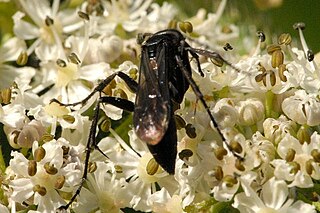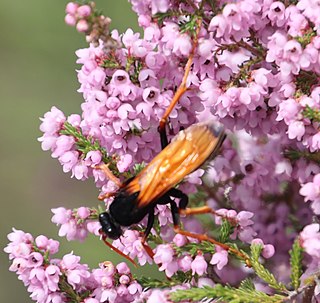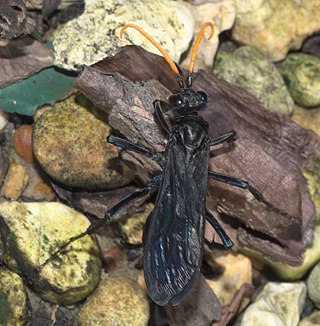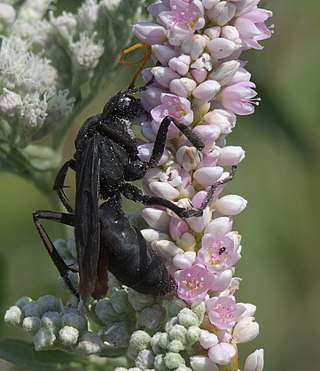
Velvet ants (Mutillidae) are a family of more than 7,000 species of wasps whose wingless females resemble large, hairy ants. Their common name velvet ant refers to their resemblance to an ant, and their dense pile of hair, which most often is bright scarlet or orange, but may also be black, white, silver, or gold. Their bright colors serve as aposematic signals. They are known for their extremely painful stings,, and has resulted in the common name "cow killer" or "cow ant" being applied to the species Dasymutilla occidentalis. However, mutillids are not aggressive and sting only in defense. In addition, the actual toxicity of their venom is much lower than that of honey bees or harvester ants. Unlike true ants, they are solitary, and lack complex social systems.

A tarantula hawk is a spider wasp (Pompilidae) that preys on tarantulas. Tarantula hawks belong to any of the many species in the genera Pepsis and Hemipepsis. They are one of the largest parasitoid wasps, using their sting to paralyze their prey before dragging it to a brood nest as living food; a single egg is laid on the prey, hatching to a larva which eats the still-living host. They are found on all continents other than Europe and Antarctica.

Wasps in the family Pompilidae are commonly called spider wasps, spider-hunting wasps, or pompilid wasps. The family is cosmopolitan, with some 5,000 species in six subfamilies. Nearly all species are solitary, and most capture and paralyze prey, though members of the subfamily Ceropalinae are kleptoparasites of other pompilids, or ectoparasitoids of living spiders.

The Schmidt sting pain index is a pain scale rating the relative pain caused by different hymenopteran stings. It is mainly the work of Justin O. Schmidt, who was an entomologist at the Carl Hayden Bee Research Center in Arizona. Schmidt published a number of works on the subject and claimed to have been stung by the majority of stinging Hymenoptera.

Pepsis is a genus of spider wasps belonging to the family Pompilidae. Species within this genus are also called tarantula hawks, as they usually hunt tarantulas, similarly to many species in the genus Hemipepsis. These wasps are restricted to the Americas, with the related genus Hemipepsis occurring in both Old and New Worlds.

Tarantulas comprise a group of large and often hairy spiders of the family Theraphosidae. As of December 2023, 1,100 species have been identified, with 166 genera. The term "tarantula" is usually used to describe members of the family Theraphosidae, although many other members of the same infraorder (Mygalomorphae) are commonly referred to as "tarantulas" or "false tarantulas". Some of the more common species have become popular in the exotic pet trade. Many New World species kept as pets have setae known as urticating hairs that can cause irritation to the skin, and in extreme cases, cause damage to the eyes.

A wasp is any insect of the narrow-waisted suborder Apocrita of the order Hymenoptera which is neither a bee nor an ant; this excludes the broad-waisted sawflies (Symphyta), which look somewhat like wasps, but are in a separate suborder. The wasps do not constitute a clade, a complete natural group with a single ancestor, as bees and ants are deeply nested within the wasps, having evolved from wasp ancestors. Wasps that are members of the clade Aculeata can sting their prey.

The Texas brown tarantula, Aphonopelma hentzi, also known as the Oklahoma brown tarantula or Missouri tarantula, is one of the most common species of tarantula living in the Southern United States today. Texas brown tarantulas can grow to leg spans in excess of 10 cm (4 in), and weigh more than 85 g (3 oz) as adults. Their bodies are dark brown, though shades may vary between individual tarantulas. The colors are more distinct after a molt, as with many arthropods.

The Pepsinae are a subfamily of the spider wasp family, Pompilidae, including the two genera of large tarantula hawks, as well as many genera of smaller species.

Anoplius nigerrimus is a species of spider wasp, or pompilid, and is the type species of the genus Anoplius.

Hemipepsis ustulata is a species of tarantula hawk wasp native to the Southwestern United States. Tarantula hawks are a large, conspicuous family of long-legged wasps that prey on tarantulas by using their long legs to grapple with their prey and then paralyze them with a powerful sting. They are solitary, displaying lekking territorial behavior in their mating rituals.

Pepsis albocincta is a species of spider wasps belonging to the family Pompilidae.

Tachypompilus ferrugineus, the rusty spider wasp, red-tailed spider hunter, or sometimes red-tailed spider wasp is a species of spider wasp from the Americas. It preys mainly on wandering spiders, especially wolf spiders.

Poecilopompilus interruptus is a species of New World spider wasps.

Hemipepsis is a genus of large pepsine spider wasps found throughout the tropics. They are commonly known as tarantula hawks. Hemipepsis wasps are morphologically similar to the related genera Pepsis and Entypus, but distinguishable by the pattern of wing venation. In South Africa 18 plant species from three plant families, the Apocynaceae, Orchidaceae, and Asparagaceae subfamily Scilloideae are pollinated exclusively by Hemipepsis wasps.

Pepsis grossa is a very large species of pepsine spider wasp from the southern part of North America, south to northern South America. It preys on tarantula spiders, giving rise to the name tarantula hawk for the wasps in the genus Pepsis and the related Hemipepsis. Only the females hunt, so only they are capable of delivering a sting, which is considered the second most painful of any insect sting; scoring 4.0 on the Schmidt sting pain index compared to the bullet ant's 4.0+. It is the state insect of New Mexico. The colour morphs are the xanthic orange-winged form and the melanic black winged form. In northern South America, a third form, known as "lygamorphic", has a dark base to the wings which have dark amber median patches and a pale tip.

Allochares azureus is a species of spider wasp from the family Pompilidae, it is the only member of the monotypic genus Allochares. It occurs in the southern part of North America and is a specialist parasitoid of the Southern house spider.

Pepsis menechma, the elegant tarantula hawk, is a species of spider wasp in the family Pompilidae, widely distributed in North America and Central America. It has numerous very different color forms over its range, and has been historically classified as several species.

Entypus fulvicornis is a species of spider wasp belonging to the family Pompilidae. It is found in North America.

Pepsis mildei, also known as Milde's tarantula-hawk wasp, is a species of predatory spider wasp native to the Western Hemisphere. These wasps capture live tarantulas to feed to their larva; the adults graze on flowers. Tarantula hawks generally have no meaningful predators. The wing color is black and/or orange, with rare leucistic wing coloration known in males. The wings of P. mildei are duller overall than those of Pepsis grossa or Pepsis cinnabarina. Per Edward Essig, Milde's tarantula-hawk wasp usually measures 20–30 millimeters in length and is a metallic blue-black overall, with "the antennae reddish, dusky at extreme base in the male and the basal third dusky in the female; the wings fiery red with the bases and apices dusky". In all tarantula wasps, the antennae can be used to distinguish between males and female: males are straight or gently arced, while the females have curved antennae. The lifespan of males is one to two months, while female Milde's tarantula-hawk wasps live for a longer span of time.



















